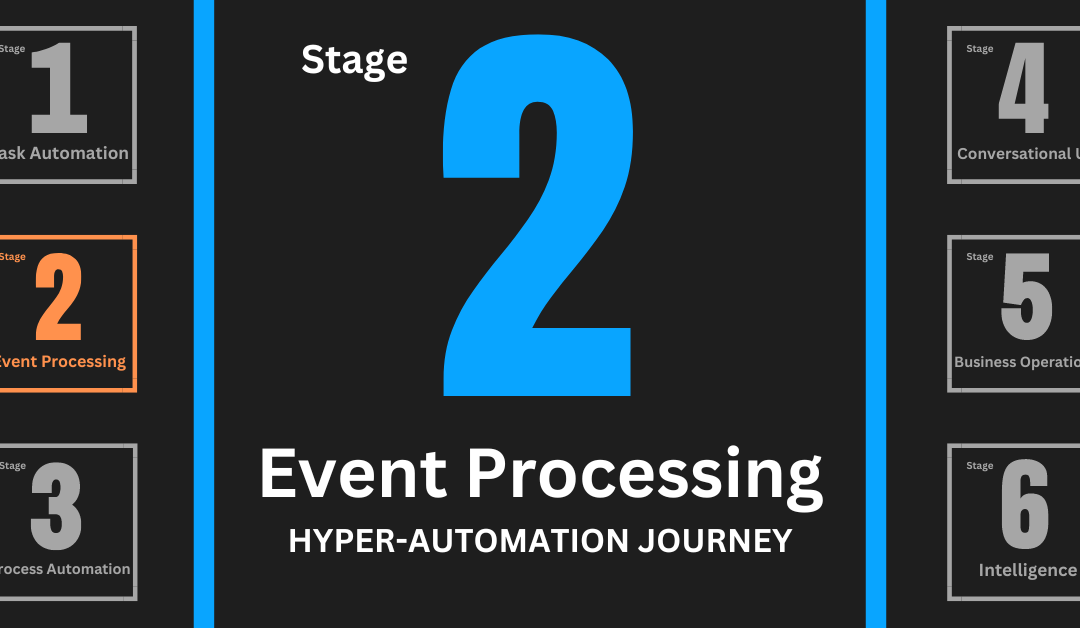Hyper-automation is a transformative approach that employs advanced technologies to automate processes end-to-end, leading to increased efficiency, productivity, and improved operational outcomes. It’s a journey that begins with task automation, and subsequently moves through different stages including event processing, process automation, conversational UX, digital operations, and finally culminates in intelligence. In our previous post, we discussed task automation, the foundational step of the hyper-automation journey. Now, let’s explore the second stage – event processing.
Understanding Event Processing
Before diving into the nitty-gritty of event processing, it’s essential to understand what an ‘event’ means in the context of AI and automation. An event can be any action or occurrence to which an organization needs to respond. It could be an external customer placing an order, a system failure, or even an internal employee filing for leave.
Event processing, thus, refers to the practice of tracking and analyzing these events and then making a decision or carrying out an action accordingly. In hyper-automation, event processing involves automating this decision-making process, enabling quick and efficient responses to events as they occur.
While task automation focuses on automating individual repetitive tasks, event processing takes it one level higher. It doesn’t just automate tasks; it ensures these tasks respond effectively to specific triggers or ‘events’, thereby creating a connected and cohesive automated process.
For example, consider a logistics company that manages warehouse operations. Through event processing, the system could automatically initiate the restocking process whenever inventory levels for a certain product drop below a set threshold, ensuring that there’s never a shortage.
Another example could be a hotel management system which monitors room occupancy. Upon checkout of a guest, an event would be triggered which notifies the housekeeping department to clean the room, ensuring a quick turnaround for the next guest.
Similarly, industries such as healthcare, finance, e-commerce, and manufacturing can all leverage event processing for swifter and more accurate interactions with their customers or employees. Event processing can also extend into supply chain management, predicting needs, automating order placements, and providing proactive solutions to clients or employees.
The Importance of Event Processing
Streamlined Operations: Event processing automates responses to specific triggers, this helps in eliminating delays that might arise due to manual intervention. This results in smoother and more streamlined operations.
Real-Time Responses: In today’s fast-paced business environment, timeliness is critical for any business. Event processing enables real-time response to events, ensuring your business can react promptly and efficiently to changes and opportunities.
Improved Decision Making: By automating responses to events, organizations can ensure decisions are made based on predefined criteria, thus eliminating the risk of human error and bias. This leads to more accurate and consistent decision-making.
Enhanced Customer Service: Event processing can be used to enhance customer service. For instance, if a customer places an order, event processing can trigger an immediate confirmation email, followed by regular updates about the order status. This can significantly improve the customer experience.
Implementing Event Processing with ccRobot.ai
ccRobot.ai offers a powerful platform for implementing event processing as part of your hyper-automation journey. Its advanced AI capabilities enable it to effectively track and analyze events and automate responses.
Whether it’s responding to a customer query, initiating a process upon receipt of an order, or sending notifications about system updates, ccRobot.ai can automate these responses, making your operations more efficient and effective.
Example Event Processing Use Case: MSCA
Let’s look at how event processing plays out in a real-world scenario with My Service Canada Account (MSCA) and ccRobot.ai.
MSCA is an online portal that allows Canadians to access various government programs. In early 2020, the MSCA saw a sudden surge in webpage traffic due to the COVID-19 pandemic. This spike in inquiries was a challenge for the traditional customer service model.
ccRobot.ai implemented a digital concierge for the MSCA to manage this increase. Each incoming user inquiry was considered an ‘event,’ which the virtual assistant processed by providing a personalized response. Additionally, ccRobot.ai conducted surveys and guided users through the MSCA portal, demonstrating the versatility in event processing. This highlights the practical significance of event processing as the second step in the hyper-automation journey.
Click here to learn more about MSCA and ccRobot.ai.
Moving Forward in the Hyper-Automation Journey
With the successful implementation of event processing, organizations take another step forward in the hyper-automation journey. After automating individual tasks and streamlining responses to events, they can then move on to more advanced stages, including process automation, conversational UX, and digital operations.
Event processing is a critical component of hyper-automation, bridging the gap between task automation and more complex automation strategies. By effectively implementing event processing, businesses can unlock greater operational efficiency and productivity, paving the way for full-scale digital transformation.
Are you ready to take the next step in your hyper-automation journey with event processing? Reach out to us at info@korahlimited.com to learn more about how ccRobot.ai can transform your business operations.
Stay tuned for our next post, where we’ll explore stage 3 of the hyper-automation journey – process automation.

